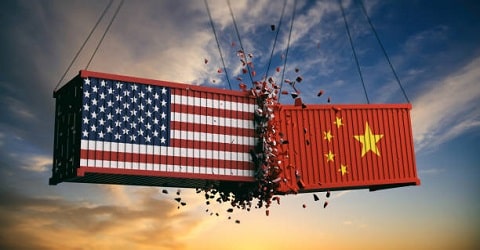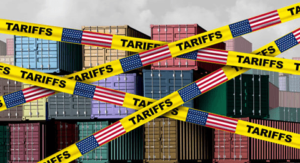
US-China Trade War Threatens Global Economic Stability
The US-China trade war, escalating with the introduction of new import tariffs, threatens global economic stability, particularly for developing nations. Caught in the crossfire of the world’s two largest economies, these nations face potential sanctions and erosion of their comparative advantages like cheap labor and land.
As Michael Porter emphasized, national prosperity isn’t inherited but created through innovation and competitiveness. Yet, as Europe rethinks its business model post-Ukraine crisis and China’s dominance grows, developing countries struggle to compete.
To navigate these challenges, investment in digital infrastructure, education, and sustainable development is crucial. However, the hope remains that a grand bargain between the US and China emerges to avert further conflict.
US-China Trade War
The trade war between the United States and China has significantly impacted the global economy, affecting developing countries and advanced economies alike. As the world’s two largest economies engage in escalating tariff battles, the ramifications are far-reaching and multifaceted.
This article explores the key aspects and consequences of the US-China trade war in seven crucial points.
Read More: Global Political Instability Signals for Rethinking Political Economics
Table of Contents
1. Sino-American Trade Tensions and Developing Economies
The recent introduction of import tariffs on Chinese goods by the United States, as part of the ongoing US-China trade war, has intensified trade tensions between the world’s two largest economies, bringing them to the brink of economic conflict.
Developing countries are at risk of collateral damage, as they might face sanctions or trade restrictions if perceived to be aiding one side. Additionally, these tensions are diminishing the value of developing countries’ comparative advantages, such as cheap labor and land, necessitating adept economic strategies to navigate the challenges.
Read More: The Irony of American-Chinese Economic Relations
2. Dynamic Nature of Comparative and Competitive Advantages
Comparative and competitive advantages are not static; they can be acquired or lost over time. Michael Porter emphasized that national prosperity is created through innovation and industry upgrades rather than relying solely on natural endowments or economic fundamentals.
As countries implement industrial policies, ranging from tariffs to structural reforms, their ability to innovate and upgrade becomes crucial for maintaining competitiveness. This is a challenge for both advanced and developing economies, especially amidst global economic uncertainties exacerbated by events such as the US-China trade war.
Read More: The Interaction Between Economic Policies and Identity Politics
3. Europe’s Economic Model and Competitiveness Challenges
Europe’s economic model, focused on high-quality engineering products, faced significant challenges following Russia’s invasion of Ukraine in 2022. Disrupted supply chains, increased energy costs, and inflation exposed Europe’s reliance on external sources for critical goods.
Additionally, the US-China trade war and China’s dominance in electric vehicles have heightened Europe’s concerns about its future competitiveness. Despite some European economies being highly competitive, larger ones like Germany and France have slipped in global rankings.
4. Productivity and Economic Performance in Europe
A McKinsey Global Institute report highlights that Europe excels in sustainability and inclusivity but lags in per capita GDP compared to the United States, especially amidst the challenges posed by the US-China trade war.
In 2022, European per capita GDP was 27% lower than that of the US, attributed to fewer working hours and lower productivity levels. Boosting productivity is now a key focus for European policymakers, with an emphasis on developing high-tech industries to close the gap.
Read More: Crucial Role of European People’s Party
5. US Innovation and High-Tech Leadership
The US allocates 3.5% of its GDP to research and development (R&D), fostering a robust environment for innovation. Although lower than South Korea and Israel, US R&D spending is significantly higher than China and the European Union, despite the challenges posed by the US-China trade war.
The US private sector drives substantial investment in R&D, supported by government incentives like the Inflation Reduction Act. This “virtuous cycle of innovation” maintains America’s technological edge, exemplified by its dominance in the semiconductor industry, where it holds a significant market share and profit margins.
Read More: Geopolitics of Economic Development in the Middle East
6. Capital Markets and Funding for Innovation
The success of the US in high-tech sectors, amidst challenges like the US-China trade war, is bolstered by its large and dynamic capital market. In 2022, the total market capitalization of the US stock market was 2.5 times higher than Europe’s.
The deep capital markets in the US enable funding for high-risk R&D and talent retention. Other economies, including China (65.4%), Japan (126%), Germany (45.5%), and India (103.7%) struggle to match this due to more risk-averse banking systems, limiting their capacity to compete in high-tech industries.
Read More: The Economics of War: A Comprehensive Analysis
7. Developing Countries and Technological Upgrading
China’s dominance in mid-tech and high-tech industries poses a challenge for developing countries attempting to compete. Since 2014, China has led in high-technology exports, holding over 30% of the global market share.
Developing countries face difficulties in financing investments and achieving economies of scale, making economic statecraft crucial. Priorities include investing in digital infrastructure, education, and projects aligned with the United Nations Sustainable Development Goals.
As protectionism rises, support for domestic champions will likely increase, potentially leading to more fragmented markets. The hope is that the US-China trade war and China reach a resolution to avoid further escalation of their economic rivalry.
Read More: The Cost of De-Dollarization
Bottom Line
In conclusion, the US-China trade war underscores the complexities and interdependencies of the global economy. As advanced economies like the US and Europe navigate their own sets of challenges, including the ramifications of the US-China trade war, developing countries must innovate and adapt to maintain competitiveness.
The capacity to innovate, invest in R&D, and develop resilient industrial policies will be critical for all nations as they contend with the ongoing economic turbulence.





